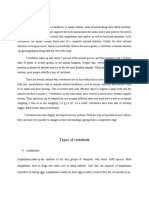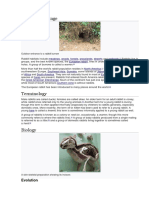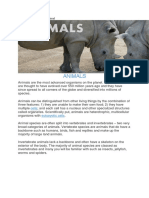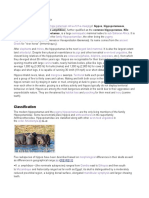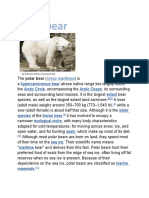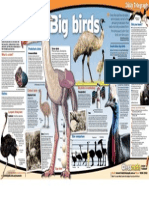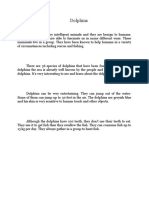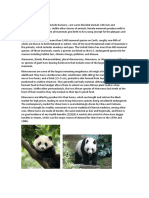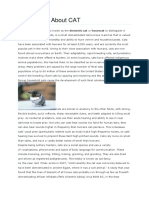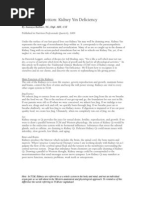Animal
Animal
Uploaded by
Judin BellCopyright:
Available Formats
Animal
Animal
Uploaded by
Judin BellCopyright
Available Formats
Share this document
Did you find this document useful?
Is this content inappropriate?
Copyright:
Available Formats
Animal
Animal
Uploaded by
Judin BellCopyright:
Available Formats
Rabbits are small mammals in the family Leporidae of the order Lagomorpha, found in several parts of the world.
There are seven different genera in the family classified as rabbits, including the European rabbit (Oryctolagus cuniculus), cottontail rabbits (genus Sylvilagus; 13 species), and the Amami rabbit (Pentalagus furnessi, an endangered species on Amami shima, Japan). There are many other species of rabbit, and these, along with pikas and hares, make up the order Lagomorpha. he giraffe (Giraffa camelopardalis) is an African even-toed ungulate mammal, the tallest of all land-living animal species, and the largest ruminant. The giraffe's scientific name, which is similar to its antiquated English name of camelopard, refers to its irregular patches of color on a light background, which bear a token resemblance to a leopard's spots. The average mass for an adult male giraffe is 1,200 kilograms (2,600 lb) while the average mass for an adult female is 830 kilograms (1,800 lb).[3][4] It is approximately 4.3 metres (14 ft) to 5.2 metres (17 ft) tall, although the tallest male recorded stood almost 6 metres (20 ft).[3][4]
he giraffe (Giraffa camelopardalis) is an African even-toed ungulate mammal, the tallest of all land-living animal species, and the largest ruminant. The giraffe's scientific name, which is similar to its antiquated English name of camelopard, refers to its irregular patches of color on a light background, which bear a token resemblance to a leopard's spots. The average mass for an adult male giraffe is 1,200 kilograms (2,600 lb) while the average mass for an adult female is 830 kilograms (1,800 lb).[3][4] It is approximately 4.3 metres (14 ft) to 5.2 metres (17 ft) tall, although the tallest male recorded stood almost 6 metres (20 ft).[3][4] The giraffe is related to other even-toed ungulates, such as deer and cattle, but is placed in a separate family, the Giraffidae, consisting of only the giraffe and its closest relative, the okapi. Its range extends from Chad in Central Africa to South Africa. Giraffes usually inhabit savannas, grasslands, or open woodlands. However, when food is scarce they will venture into areas with denser vegetation. They prefer areas with plenty of acacia growth. They will drink large quantities of water when available, which enables them to live for extended periods in dry, arid areas. The hairs in a giraffe's fur also works as a chemical defence, and is full of antibiotics and parasite repellents which gives the animal a characteristic scent.[citation needed] Old males are sometimes nicknamed "stink bulls". There are at least eleven main smelly chemicals in the fur, although it is indole and 3-methylindole which is responsible for most of their smell. Because the males have a stronger odour than the females, it is also assumed that it has a sexual function as well.[5]
The cat (Felis catus), also known as the domestic cat or housecat[5] to distinguish it from other felines and felids, is a small domesticated carnivorous mammal that is valued by humans for its companionship and ability to hunt vermin and household pests. Cats have been associated with humans for at least 9,500 years,[6] and are currently the most popular pet in the world.[7] Owing to their close association with humans, cats are now found almost everywhere on Earth. Cats are similar in anatomy to the other felids, with strong, flexible bodies, quick reflexes, sharp retractable claws, and teeth adapted to killing small prey. As nocturnal predators, cats use their acute hearing and ability to see in near darkness to locate prey. Not only can cats hear sounds too faint for human ears, they can also hear sounds higher in frequency than humans can perceive. This is because cats' usual prey (particularly rodents such as mice) make high frequency noises, so cats' hearing has evolved to pinpoint these faint high-pitched sounds. Cats rely more on smell than taste, and have a vastly better sense of smell than humans. Despite being solitary hunters, cats are a social species and use a variety of vocalizations, pheromones and types of body language for communication. These include meowing, purring, trilling, hissing, growling, and grunting.[8]
The dog (Canis lupus familiaris[1]) is a domesticated form of the gray wolf, a member of the Canidae family of the order Carnivora. The term is used for both feral and pet varieties. The domestic dog has been the most widely kept working, hunting and companion animal in human history. The word "dog" may also mean the male of a canine species,[2] as opposed to the word "bitch" for the female of the species.[3] The dog quickly became ubiquitous across world cultures, and was extremely valuable to early human settlements. For instance, it is believed that the successful emigration across the Bering Strait might not have been possible without sled dogs.[4] Dogs perform many roles for people, such as hunting, herding, protection, assisting police and military, companionship, and, more recently, aiding handicapped individuals. This versatility, more than almost any other known animal, has given them the nickname "Man's best friend" in the western world. Currently, there are estimated to be 400 million dogs in the world.[5]
Birds (class Aves) are winged, bipedal, endothermic (warm-blooded), egg-laying, vertebrate animals. There are around 10,000 living species, making them the most varied of tetrapod vertebrates. They inhabit ecosystems across the globe, from the Arctic to the Antarctic. Extant birds range in size from the 5 cm (2 in) Bee Hummingbird to the 2.75 m (9 ft) Ostrich. The fossil record indicates that birds evolved from theropod dinosaurs during the Jurassic period, around 150200 Ma (million years ago), and the earliest known bird is the Late Jurassic Archaeopteryx, c 150145 Ma. Most paleontologists regard birds as the only clade of dinosaurs to have survived the CretaceousTertiary extinction event approximately 65.5 Ma. Modern birds are characterised by feathers, a beak with no teeth, the laying of hard-shelled eggs, a high metabolic rate, a four-chambered heart, and a lightweight but strong skeleton. All living species of birds have wings - the now extinct flightless Moa of New Zealand were the only exceptions. Wings are evolved forelimbs, and most bird species can fly, with some exceptions including ratites, penguins, and a number of diverse endemic island species. Birds also have unique digestive and respiratory systems that are highly adapted for flight. Some birds, especially corvids and parrots, are among the most intelligent animal species; a number of bird species have been observed manufacturing and using tools, and many social species exhibit cultural transmission of knowledge across generations. Many species undertake long distance annual migrations, and many more perform shorter irregular movements. Birds are social; they communicate using visual signals and through calls and songs, and participate in social behaviours including cooperative breeding and hunting, flocking, and mobbing of predators. The vast majority of bird species are socially monogamous, usually for one breeding season at a time, sometimes for years, but rarely for life. Other species have breeding systems that are polygynous ("many females") or, rarely, polyandrous ("many males"). Eggs are usually laid in a nest and incubated by the parents. Most birds have an extended period of parental care after hatching.
A monkey is any cercopithecoid (Old World monkey) or platyrrhine (New World monkey) primate. All primates that are not prosimians or apes are monkeys. The 264 known extant monkey species represent two of the three groupings of simian primates (the third group being the 21 species of apes). Monkeys are generally considered to be intelligent and, unlike apes, monkeys usually have tails. The New World monkeys are classified within the parvorder Platyrrhini, whereas the Old World monkeys (superfamily Cercopithecoidea) form part of the parvorder Catarrhini, which also includes the apes. Thus, scientifically speaking, monkeys are paraphyletic (not a single coherent group) and Old World monkeys are actually more closely related to the apes than they are to the New World monkeys.
A fish is any aquatic vertebrate animal that is covered with scales, and equipped with two sets of paired fins and several unpaired fins. Most fish are "cold-blooded", or ectothermic, allowing their body temperatures to vary as ambient temperatures change. Fish are abundant in most bodies of water. They can be found in nearly all aquatic environments, from high mountain streams (e.g., char and gudgeon) to the abyssal and even hadal depths of the deepest oceans (e.g., gulpers and anglerfish). At 31,500 species, fish exhibit greater species diversity than any other class of vertebrates.[1] Food prepared from animals classified as fish is also referred to as fish, and is an important human food source. Commercial and subsistence fishers "hunt" fish in wild fisheries (see fishing) or "farm" them in ponds or in cages in the ocean (see aquaculture). They are also caught by recreational fishers and raised by fishkeepers, and are exhibited in public aquaria. Fish have had a role in culture through the ages, serving as deities, religious symbols, and as the subjects of art, books and movies.
Duck is the common name for a number of species in the Anatidae family of birds. The ducks are divided between several subfamilies in the Anatidae family; they do not represent a monophyletic group but a form taxon, since swans and geese are not considered ducks. Ducks are mostly aquatic birds, mostly smaller than the swans and geese, and may be found in both fresh water and sea water. Ducks are sometimes confused with several types of unrelated water birds with similar forms, such as loons or divers, grebes, gallinules, and coots.
Contents
[hide]
The chicken (Gallus gallus domesticus) is a domesticated fowl, a subspecies of the Red Jungle Fowl. As one of the most common and widespread domestic animals, and with a population of more than 24 billion in 2003,[1] there are more chickens in the world than any other species of bird. Humans keep chickens primarily as a source of food, consuming both their meat and their eggs. Conventional wisdom has held that the chicken was domesticated in India,[2] but recent evidence suggests that domestication of the chicken was already under way in Vietnam over 10,000 years ago.[2] From India the domesticated fowl made its way to the Persianized kingdom of Lydia in western Asia Minor, and domestic fowl were imported to Greece by the fifth century BC.[3] Fowl had been known in Egypt since the 18th Dynasty, with the "bird that lays every day" having come to Egypt from the land between Syria and Shinar, Babylonia, according to the annals of Tutmose III.[4]
Elephants are large land mammals in two genera of the family Elephantidae: Elephas and Loxodonta. Three species of elephant are living today: the African bush elephant, the African forest elephant and the Asian elephant (also known as the Indian elephant). All other species and genera of Elephantidae are extinct, some since the last ice age although dwarf forms of mammoths may have survived as late as 2,000 BC.[1] Elephants and other Elephantidae were once classified with other thick-skinned animals in a now invalid order, Pachydermata. Elephants are the largest land animals now living.[2] The elephant's gestation period is 22 months, the longest of any land animal. At birth it is common for an elephant calf to weigh 120 kilograms (260 lb). They typically live for 50 to 70 years, but the oldest recorded elephant lived for 82 years.[3] The largest elephant ever recorded was shot in Angola in 1956. This male weighed about 24,000 lb (11,000 kg),[4] with a shoulder height of 3.96 metres (13.0 ft), a metre (yard) taller than the average male African elephant.[5] The smallest elephants, about the size of a calf or a large pig, were a prehistoric species that lived on the island of Crete during the Pleistocene epoch.[6] Elephants are a symbol of wisdom in Asian cultures and are famed for their memory and intelligence, where they are thought to be on par with cetaceans[7] and hominids.[8] Aristotle once said the elephant was "the beast which passeth all others in wit and mind".[9] The word "elephant" has its origins in the Greek , meaning "ivory" or "elephant".[10] According to observations, healthy adult elephants have no natural predators,[11] although lions may take calves or weak individuals.[12][13] They are, however, threatened by human intrusion and poaching.
Spiders (order Araneae) are air-breathing arthropods that have eight legs, and chelicerae with fangs that inject venom. They are the largest order of arachnids and rank seventh in total species diversity among all other groups of organisms.[1] Spiders are found worldwide on every continent except for Antarctica, and have become established in nearly every habitat with the exception of air and sea colonization. As of 2008, approximately 40,000 spider species, and 109 families have been recorded by taxonomists;[2] however, there has been confusion within the scientific community as to how all these families should be classified, as evidenced by the over 20 different classifications that have been proposed since 1900.[3] Anatomically, spiders differ from other arthropods in that the usual body segments are fused into two tagmata, the cephalothorax and abdomen, and joined by a small, cylindrical pedicel. Unlike insects, spiders do not have antennae. In all except the most primitive group, the Mesothelae, spiders have the most centralized nervous systems of all arthropods, as all their ganglia are fused into one mass in the cephalothorax. Unlike most arthropods, spiders have no extensor muscles in their limbs and instead extend them by hydraulic pressure. Their abdomens bear appendages that have been modified into spinnerets that extrude silk from up to six types of silk glands within their abdomen. Spider webs vary widely in size, shape and the amount of sticky thread used. It now appears that the spiral orb web may be one of the earliest forms, and spiders that produce tangled cobwebs are more abundant and diverse than orb-web spiders. Spider-like arachnids with silk-producing spigots appear in the Devonian period about 386 million years ago, but these animals apparently lacked spinnerets. True spiders have been found in Carboniferous rocks from 318 to 299 million years ago, and are very similar to the most primitive surviving order, the Mesothelae. The main groups of modern spiders, Mygalomorphae and Araneomorphae, first appear in the Triassic period, before 200 million years ago.
he Giant Panda (Ailuropoda melanoleuca, literally meaning "black and white cat-foot")[2] is a bear[3] native to central-western and south western China.[4] It is easily recognized by its large, distinctive black patches around the eyes, over the ears, and across its round body. Though it belongs to the order Carnivora, the Giant Panda's diet is 99% bamboo.[5] Other parts of its diet include honey, eggs, fish, yams, shrub leaves, oranges, and bananas when available.[6] The Giant Panda lives in a few mountain ranges in central China, mainly in Sichuan province, but also in the Shaanxi and Gansu provinces.[7] Due to farming, deforestation and other development, the Giant Panda has been driven out of the lowland areas where it once lived. The Giant Panda is a conservation reliant endangered species.[4] A 2007 report shows 239 Giant Pandas living in captivity inside China and another 27 outside the country.[8] Wild population estimates vary; one estimate shows that there are about 1,590 individuals living in the wild,[8] while a 2006 study via DNA analysis estimated that this figure could be as high as 2,000 to 3,000.[9] Some reports also show that the number of Giant Pandas in the wild is on the rise.[10][11] However, the IUCN does not believe there is enough certainty yet to reclassify the species from Endangered to Vulnerable.[1] While the dragon has historically served as China's national emblem, in recent decades the Giant Panda has also served as an emblem for the country. Its image appears on a large number of modern Chinese commemorative silver, gold, and platinum coins. Though the Giant Panda is often assumed to be docile, it has been known to attack humans, presumably out of irritation rather than predation.[12][13][14]
The tiger (Panthera tigris), a member of the Felidae family, is the largest of the four "big cats" in the genus Panthera.[4] Native to much of eastern and southern Asia, the tiger is an apex predator and an obligate carnivore. Reaching up to 3.3 metres (11 ft) in total length, weighing up to 300 kilograms (660 pounds), and having canines up to 4 inches long,[5] the larger tiger subspecies are comparable in size to the biggest extinct felids.[6][7] Aside from their great bulk and power, their most recognisable feature is a pattern of dark vertical stripes that overlays nearwhite to reddish-orange fur, with lighter underparts. The most numerous tiger subspecies is the Bengal tiger while the largest is the Siberian tiger. Tigers have a lifespan of 1015 years in the wild, but can live longer than 20 years in captivity.[8] They are highly adaptable and range from the Siberian taiga to open grasslands and tropical mangrove swamps. They are territorial and generally solitary animals, often requiring large contiguous areas of habitat that support their prey demands. This, coupled with the fact that they are indigenous to some of the more densely populated places on earth, has caused significant conflicts with humans. Three of the nine subspecies of modern tiger have gone extinct, and the remaining six are classified as endangered, some critically so. The primary direct causes are habitat destruction, fragmentation and hunting. Historically tigers have existed from Mesopotamia and the Caucasus throughout most of South and East Asia. Today the range of the species is radically reduced. While all surviving species are under formal protection, poaching, habitat destruction and inbreeding depression continue to threaten the tigers. Tigers are among the most recognizable and popular of the world's charismatic megafauna. They have featured prominently in ancient mythology and folklore, and continue to be depicted in modern films and literature. Tigers appear on many flags and coats of arms, as mascots for sporting teams, and as the national animal of several Asian nations, including India.[9]
The lion (Panthera leo) is one of the four big cats in the genus Panthera, and a member of the family Felidae. With some males exceeding 250 kg (550 lb) in weight,[4] it is the second-largest living cat after the tiger. Wild lions currently exist in Sub-Saharan Africa and in Asia with a critically endangered remnant population in Gir Forest National Park in India, having disappeared from North Africa and Southwest Asia in historic times. Until the late Pleistocene, about 10,000 years ago, the lion was the most widespread large land mammal after humans. They were found in most of Africa, across Eurasia from western Europe to India, and in the Americas from the Yukon to Peru.[5] Lions live for ten to fourteen years in the wild, while in captivity they can live longer than twenty years. In the wild, males seldom live longer than ten years, as injuries sustained from continual fighting with rival males greatly reduce their longevity.[6] They typically inhabit savanna and grassland, although they may take to bush and forest. Lions are unusually social compared to other cats. A pride of lions consists of related females and offspring and a small number of adult males. Groups of female lions typically hunt together, preying mostly on large ungulates. Lions are apex and keystone predators, although they scavenge as opportunity allows. While lions do not typically hunt humans, some have been known to do so.
True crabs are decapod crustaceans of the infraorder Brachyura, which typically have a very short projecting "tail" (Greek: / brachys = short, [2] / ura = tail[3]), or where the reduced abdomen is entirely hidden under the thorax. Other animals, such as hermit crabs, king crabs, porcelain crabs, horseshoe crabs and crab lice, are not true crabs.
Frogs are amphibians in the order Anura (meaning "tail-less", from Greek an-, without + oura, tail), formerly referred to as Salientia (Latin salere (salio), "to jump"). Most frogs are characterized by a short body, webbed digits (fingers or toes), protruding eyes and the absence of a tail. Frogs are widely known as exceptional jumpers, and many of the anatomical characteristics of frogs, particularly their long, powerful legs, are adaptations to improve jumping performance. Due to their permeable skin, frogs are often semi-aquatic or inhabit humid areas, but move easily on land. They typically lay their eggs in puddles, ponds or lakes, and their larvae, called tadpoles, have gills and develop in water. Adult frogs follow a carnivorous diet, mostly of arthropods, annelids and gastropods. Frogs are most noticeable by their call, which can be widely heard during the night or day, mainly in their mating season. The distribution of frogs ranges from tropic to subarctic regions, but most species are found in tropical rainforests. Consisting of more than 5,000 species described, they are among the most diverse groups of vertebrates. However, populations of certain frog species are declining significantly.
A crocodile is any species belonging to the family Crocodylidae (sometimes classified instead as the subfamily Crocodylinae). The term can also be used more loosely to include all extant members of the order Crocodilia: i.e. the true crocodiles, the alligators and caimans (family Alligatoridae) and the gharials (family Gavialidae), as well as the Crocodylomorpha which includes prehistoric crocodile relatives and ancestors. Member species of the family Crocodylidae are large aquatic reptiles that live throughout the tropics in Africa, Asia, the Americas and Australia. Crocodiles tend to congregate in freshwater habitats like rivers, lakes, wetlands and sometimes in brackish water. They feed mostly on vertebrates like fish, reptiles, and mammals, sometimes on invertebrates like mollusks and crustaceans, depending on species. They are an ancient lineage, and are believed to have changed little since the time of the dinosaurs. They are believed to be 200 million years old whereas dinosaurs became extinct 65 million years ago; crocodiles survived great extinction events.[1]
Snail is a common name for almost all members of the molluscan class Gastropoda that have coiled shells in the adult stage. When the word is used in a general sense, it includes sea snails, land snails and freshwater snails. Otherwise snail-like creatures that lack a shell (or have only a very small one) are called slugs. One species of land snail, the Giant African Snail, can grow to be 15 inches (38 cm) from snout to tail, and weigh 2 pounds (0.91 kg). The largest living species of sea snail is Syrinx aruanus which has a shell that can measure up to 91 cm (36 in) in length, and the whole animal with the shell can weigh up to 18 kg (40 lb). Snails can be found in a very wide range of environments including ditches, deserts, and the abyssal depths of the sea. Although many people are familiar with terrestrial snails, land snails are in the minority. Marine snails constitute the majority of snail species, and have much greater diversity and a greater biomass. Numerous kinds of snail can also be found in fresh waters. Many snails are herbivorous, though a few land species and many marine species are omnivores or predatory carnivores.
Snakes are elongate, legless, carnivorous reptiles of the suborder Serpentes that can be distinguished from legless lizards by their lack of eyelids and external ears. Like all squamates, snakes are ectothermic, amniote vertebrates covered in overlapping scales. Many species of snakes have skulls with many more joints than their lizard ancestors, enabling them to swallow prey much larger than their heads with their highly mobile jaws. To accommodate their narrow bodies, snakes' paired organs (such as kidneys) appear one in front of the other instead of side by side, and most have only one functional lung. Some species retain a pelvic girdle with a pair of vestigial claws on either side of the cloaca. Living snakes are found on every continent except Antarctica and on most islands. Fifteen families are currently recognized, comprising 456 genera and over 2,900 species.[1][2] They range in size from the tiny, 10 cm-long thread snake to pythons and anacondas of up to 7.6 metres (25 ft) in length. The recently discovered fossil Titanoboa was 15 metres (49 ft) long. Snakes are thought to have evolved from either burrowing or aquatic lizards during the Cretaceous period (c 150 Ma). The diversity of modern snakes appeared during the Paleocene period (c 66 to 56 Ma). Most species are nonvenomous and those that have venom use it primarily to kill and subdue prey rather than for self-defense. Some possess venom potent enough to cause painful injury or death to humans. Nonvenomous snakes either swallow prey alive or kill by const
he grasshopper is an insect of the suborder Caelifera in the order Orthoptera. To distinguish it from bush crickets or katydids, it is sometimes referred to as the short-horned grasshopper. Species that change colour and behaviour at high population densities are called locusts.
Ants are social insects of the family Formicidae (pronounced /f r m s di /) and, along with the related wasps and bees, belong to the order Hymenoptera. Ants evolved from wasp-like ancestors in the mid-Cretaceous period between 110 and 130 million years ago and diversified after the rise of flowering plants.[3] More than 12,500 out of an estimated total of 22,000 species have been classified.[4][5][6] They are easily identified by their elbowed antennae and a distinctive node-like structure that forms a slender waist. Ants form colonies that range in size from a few dozen predatory individuals living in small natural cavities to highly organised colonies which may occupy large territories and consist of millions of individuals. These larger colonies consist mostly of sterile wingless females forming castes of "workers", "soldiers", or other specialised groups. Nearly all ant colonies also have some fertile males called "drones" and one or more fertile females called "queens". The colonies are sometimes described as superorganisms because the ants appear to operate as a unified entity, collectively working together to support the colony.[7] Ants have colonised almost every landmass on Earth. The only places lacking indigenous ants are Antarctica and a few remote or inhospitable islands. Ants thrive in most ecosystems, and may form 1525% of the terrestrial animal biomass.[8] Their success in so many environments has been attributed to their social organisation and their ability to modify habitats, tap resources, and defend themselves. Their long co-evolution with other species has led to mimetic, commensal, parasitic, and mutualistic relationships.[9]
You might also like
- D&D 5E All SpellsDocument82 pagesD&D 5E All Spellsscottwelchkin99% (78)
- Introduction On Elephant (Heading 2)Document4 pagesIntroduction On Elephant (Heading 2)Divya TaraNo ratings yet
- Vertebrate and InvertebratesDocument9 pagesVertebrate and InvertebratesgwenethzNo ratings yet
- Report Text About PandaDocument17 pagesReport Text About PandaAndre Andrian0% (1)
- Tiger: This Article Is About The Feline. For Other Uses, See - "Tigress" Redirects Here. For Other Uses, SeeDocument6 pagesTiger: This Article Is About The Feline. For Other Uses, See - "Tigress" Redirects Here. For Other Uses, SeeSiddesh BhagatNo ratings yet
- Clipping Report Text (Animals) : D I S U S U N Oleh: Kelompok 6Document9 pagesClipping Report Text (Animals) : D I S U S U N Oleh: Kelompok 6masdarNo ratings yet
- Task Performance in EnsciDocument8 pagesTask Performance in EnsciPythia HecatleneNo ratings yet
- Animals of AustraliaDocument5 pagesAnimals of AustraliaShabs Zujer PatlaNo ratings yet
- HummingbirdsDocument6 pagesHummingbirdsதுளசி இன்போஸ்No ratings yet
- North American Porcupine Porc-Épic D'amérique Du Nord Puerco EspínDocument6 pagesNorth American Porcupine Porc-Épic D'amérique Du Nord Puerco EspínitsankurzNo ratings yet
- Anura (: (Hide)Document4 pagesAnura (: (Hide)kbarn389No ratings yet
- ReportDocument13 pagesReportfuad101No ratings yet
- ReptileDocument4 pagesReptileDratonius 101No ratings yet
- Habitat and Range: EvolutionDocument3 pagesHabitat and Range: Evolutionoctavianc96No ratings yet
- Company NameDocument10 pagesCompany NameRakesh DuttaNo ratings yet
- Animals: Cells Eukaryotic CellsDocument17 pagesAnimals: Cells Eukaryotic CellsFallianda YandaNo ratings yet
- RenrenDocument11 pagesRenrenIrsih PeredaNo ratings yet
- RabbitsDocument5 pagesRabbitsdinberamboNo ratings yet
- Topic EcologyDocument5 pagesTopic EcologyJavier SmithNo ratings yet
- Study of Birds: Environmental ScienceDocument6 pagesStudy of Birds: Environmental ScienceAbhi Raut100% (1)
- Pinniped: From Wikipedia, The Free EncyclopediaDocument7 pagesPinniped: From Wikipedia, The Free EncyclopediaLak DavisNo ratings yet
- 1 Text About Animal 2Document11 pages1 Text About Animal 2bratadianggaNo ratings yet
- Hippo ResearchDocument6 pagesHippo ResearchkeithNo ratings yet
- C Is A Common Name For Many Species of Omnivorous: ListenDocument1 pageC Is A Common Name For Many Species of Omnivorous: ListenHarshit GoelNo ratings yet
- What Animals Live in the Desert? Animal Book 4-6 Years Old | Children's Animal BooksFrom EverandWhat Animals Live in the Desert? Animal Book 4-6 Years Old | Children's Animal BooksNo ratings yet
- Report Text PDFDocument2 pagesReport Text PDFGregorius Melvin ivander MartinsNo ratings yet
- RabbitDocument13 pagesRabbitmcmusbixNo ratings yet
- Animal Dictionary Vol. 2Document17 pagesAnimal Dictionary Vol. 2Imran KhanNo ratings yet
- Big Birds PDFDocument1 pageBig Birds PDFatulNo ratings yet
- Mammalia LanjutanDocument28 pagesMammalia LanjutanRatih PurwaningrumNo ratings yet
- Report TextDocument22 pagesReport TextFiqri MuharamNo ratings yet
- Indian Aurochs: Sivatherium Sivatherium ('Shiva's Beast) ' Is An Extinct Genus of Giraffid That Ranged ThroughoutDocument4 pagesIndian Aurochs: Sivatherium Sivatherium ('Shiva's Beast) ' Is An Extinct Genus of Giraffid That Ranged ThroughoutBook Worm50% (2)
- Science Holiday Home WorkDocument13 pagesScience Holiday Home WorkShalini RaniNo ratings yet
- Recount Animal Kelas 10Document5 pagesRecount Animal Kelas 10Febrian FadilahNo ratings yet
- Biology 14Document7 pagesBiology 14Willian CarbajalNo ratings yet
- Gypaetus SCIENCE RESEARCHDocument10 pagesGypaetus SCIENCE RESEARCHMaerissa Gwen SangalangNo ratings yet
- Contoh Teks ReportDocument4 pagesContoh Teks ReportSelenia Marie GomezNo ratings yet
- Habitat: World's Fastest AnimalsDocument2 pagesHabitat: World's Fastest AnimalsVasareNo ratings yet
- FoxDocument3 pagesFoxAntonisNo ratings yet
- OstrichDocument2 pagesOstrichTamiru Legesse100% (1)
- MammalsDocument9 pagesMammalsrovel shelieNo ratings yet
- SquirrelDocument18 pagesSquirrelLitzy estefany Morales cortesNo ratings yet
- ZebraDocument1 pageZebrallorchscribdNo ratings yet
- Rabbit Rabbits Are Small Mammals in The Family Leporidae of The OrderDocument11 pagesRabbit Rabbits Are Small Mammals in The Family Leporidae of The Orderramperough100% (1)
- History and Origin of ParrotsDocument38 pagesHistory and Origin of ParrotsShanmukha priyaNo ratings yet
- Flying-Foxes: Poliocephalus) Is The Largest Member ofDocument10 pagesFlying-Foxes: Poliocephalus) Is The Largest Member ofSushantNo ratings yet
- Elephant Elephants Are Large Mammals of The Family: TerminologyDocument13 pagesElephant Elephants Are Large Mammals of The Family: TerminologyMukesh ManwaniNo ratings yet
- Sparrow - Wikipedia, The Free EncyclopediaDocument6 pagesSparrow - Wikipedia, The Free EncyclopediaAli XaiiNo ratings yet
- Marabou StorkDocument4 pagesMarabou StorkOkello PaulNo ratings yet
- Evolution BirdsDocument17 pagesEvolution BirdsKayode OladunjoyeNo ratings yet
- Monk Parakeet: Valex61 ShutterstockDocument3 pagesMonk Parakeet: Valex61 Shutterstockanthony beauNo ratings yet
- Crows (: L. Cyclotis Respectively) - Elephants Are Scattered ThroughoutDocument7 pagesCrows (: L. Cyclotis Respectively) - Elephants Are Scattered ThroughoutAmitVyavahareNo ratings yet
- Reptiles: Snakes Lizards Crocodiles Turtles Tuatara VertebratesDocument10 pagesReptiles: Snakes Lizards Crocodiles Turtles Tuatara VertebratesJemarkTicmonMagpayoNo ratings yet
- Philippine Eagle: TaxonomyDocument5 pagesPhilippine Eagle: TaxonomyCJ AngelesNo ratings yet
- A253 Carnivora - 105 Low RezDocument1 pageA253 Carnivora - 105 Low RezMAnsi CHoukseyNo ratings yet
- LATIHAN FACTUAL REPORTDocument6 pagesLATIHAN FACTUAL REPORTSerli ApriliantiNo ratings yet
- Biografi TemanDocument8 pagesBiografi TemanWahyupuji AstutiNo ratings yet
- Biology 10 Performance Task #3: Shelly Marie L. de La Cruz 10-LaurenciumDocument20 pagesBiology 10 Performance Task #3: Shelly Marie L. de La Cruz 10-LaurenciumShelly Marie De la CruzNo ratings yet
- Nutrition For Kidney YinDocument6 pagesNutrition For Kidney Yinbaskars39No ratings yet
- Case Study Format I. Patient Demographic Profile: 1. Pediatric and Adult IllnessDocument6 pagesCase Study Format I. Patient Demographic Profile: 1. Pediatric and Adult Illnessanon-285690No ratings yet
- Sexual and Asexual ReproductionDocument12 pagesSexual and Asexual Reproductionapi-262424911No ratings yet
- ORESOL Is "Oral Glucose-ElectrolyteDocument4 pagesORESOL Is "Oral Glucose-ElectrolyteMichelle ViduyaNo ratings yet
- Complete The Sentences With The Correct PrepositionDocument2 pagesComplete The Sentences With The Correct PrepositionOlivera MajstorovicNo ratings yet
- Hugh Baby's MenuDocument1 pageHugh Baby's MenuMattRogers123No ratings yet
- GalateaDocument21 pagesGalateaLexi RobertsNo ratings yet
- 26 Donald BroomDocument10 pages26 Donald BroomAnahi MedinaNo ratings yet
- Insecta of Medical Importance (Diptera-Mosquito)Document20 pagesInsecta of Medical Importance (Diptera-Mosquito)CLEMENTNo ratings yet
- 102 Ways To Kill PeopleDocument3 pages102 Ways To Kill PeopleLuke Braaders Bradley100% (2)
- Eriksson1998 HumanDocument5 pagesEriksson1998 HumanMaría Laura SoriaNo ratings yet
- Bio McqsDocument91 pagesBio Mcqszaim techNo ratings yet
- Minggu 3 (Medical Terminology)Document51 pagesMinggu 3 (Medical Terminology)Wiwit AndriyaniNo ratings yet
- Hyponatremia Algorithm: Onset Rapid ( 48 Hours) : 3% Onset Rapid ( 48 Hours) : May Consider 3% Nac LDocument2 pagesHyponatremia Algorithm: Onset Rapid ( 48 Hours) : 3% Onset Rapid ( 48 Hours) : May Consider 3% Nac Lmina000005100% (1)
- TBR Bio1 OptDocument333 pagesTBR Bio1 OptChris Daniels90% (10)
- AGRIC MOCK SS3Document6 pagesAGRIC MOCK SS3benjamin onumNo ratings yet
- NCP - ExtraDocument2 pagesNCP - Extranuqui08No ratings yet
- Chapter 36: Ventilation Patton: Anatomy and Physiology, 10th EditionDocument17 pagesChapter 36: Ventilation Patton: Anatomy and Physiology, 10th EditionLoretta FergusonNo ratings yet
- Reading ComprehensionDocument53 pagesReading Comprehensioncristine niegoNo ratings yet
- 11.4 - Reproduction IB BiologyDocument3 pages11.4 - Reproduction IB BiologyannehindenbergNo ratings yet
- Ayurveda ThoreyDocument15 pagesAyurveda ThoreyanantNo ratings yet
- Post Partum Hemorrhage: Akmal Abbasi, M.DDocument36 pagesPost Partum Hemorrhage: Akmal Abbasi, M.Dsharu4291No ratings yet
- Bio Mechanics Lecture NotesDocument53 pagesBio Mechanics Lecture NotesscdubalNo ratings yet
- Madness GrowsDocument58 pagesMadness GrowsBenjamin RheaultNo ratings yet
- Membrane and TransportDocument25 pagesMembrane and TransportHafsa JalisiNo ratings yet
- Size: 137 X 218 MM: Rapid Test For The Detection of Dengue NS 1 Antigen in Human Serum/plasma DeviceDocument4 pagesSize: 137 X 218 MM: Rapid Test For The Detection of Dengue NS 1 Antigen in Human Serum/plasma DeviceMatibar RahmanNo ratings yet
- African Swine Fever in The PhilippinesDocument5 pagesAfrican Swine Fever in The PhilippinesCathy Baysan Olegario CanoNo ratings yet
- Lab3 Human Anatomy 1 YearDocument51 pagesLab3 Human Anatomy 1 Yearnatheer ayedNo ratings yet
- Kinds 2 RoundwormsDocument10 pagesKinds 2 RoundwormsMelanie perez cortezNo ratings yet


